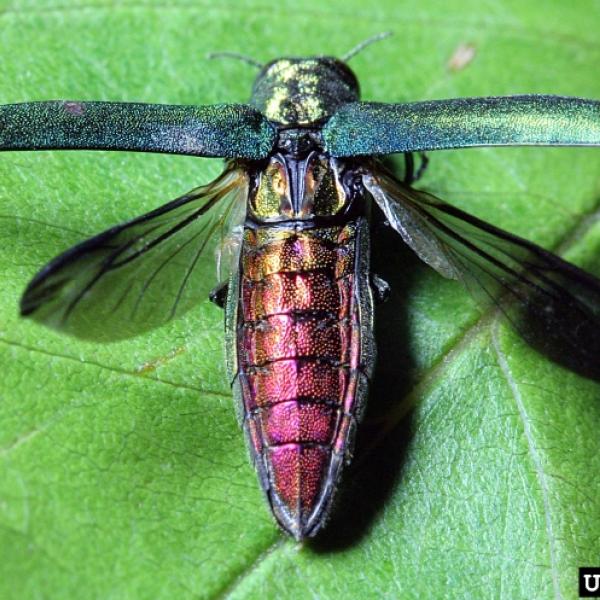
News Source
After years trying to stop the spread across state lines of an invasive beetle that destroys trees, the federal government looks about ready to give up.
The Department of Agriculture will soon propose abandoning an emerald ash borer quarantine that restricts the movement of firewood and items from ash trees, putting new emphasis on biological controls and other approaches that don't require federal regulations and, the agency said, may be more effective.
"Today, 33 states have EAB infestations, and every year the insect continues to be detected beyond the quarantine boundaries," USDA's Animal and Plant Health Inspection Service (APHIS) told E&E News. "Based on its spread, eradication is not possible."
The quarantine started in 2003 in Michigan, a few years after the borer's appearance, and has expanded gradually. Federal and state forestry officials say they believe it's slowed the insect's spread but that people sometimes unknowingly move infested wood. The biggest culprit is firewood, officials say, despite public relations campaigns to stop campers from bringing in out-of-state wood.
The beetles move on their own, too, officials said, advancing several miles a year.
Officials blame the nature of the infestation as well as a declining budget for the proposal, which APHIS said it will make through formal rulemaking in July. A final regulation would be published after a public comment period of perhaps 60 days, the agency said.
The ash borer is native to eastern Russia, northern China, Japan and Korea. It was first confirmed in North America in 2002, in Michigan, but researchers believe it was already in that area for about a decade before discovery, according to the Forest Service and Michigan State University.
In its larval stage, the insect eats water- and nutrient-conducting tissues, choking off the tree. First, the canopy thins, then branches die. Entire trees can be killed two years after the borer's appearance. As an adult, the borer becomes a half-inch-long shiny green beetle.
The Forest Service considers emerald ash borer the most destructive forest pest ever seen in North America, its economic impact potentially reaching billions of dollars.
It attacks ash trees exclusively, although the quarantine applies to all kinds of hardwood firewood. Commercially, ash is best-known for use in baseball bats, as well as in furniture and flooring.
The federal quarantine covers entire states from Massachusetts to Indiana to Georgia, as well as parts of states as far west as Colorado. Vermont, where emerald borer was recently confirmed in three counties, joined earlier this month. Maine, where the borer hasn't been spotted, isn't in the quarantine but is surrounded by areas that are, including Canadian quarantines in Quebec and Ontario.
In Vermont, a state quarantine is in effect, as well, which officials would have imposed regardless of the federal restrictions, said Steve Sinclair, the state forester.
"A quarantine is just a line on a map," Sinclair said. Still, he said, he wishes APHIS wouldn't step away from its own restrictions.
If budgeting is the problem, Sinclair said, APHIS might do better to focus on another pest, the Asian longhorned beetle, which attacks maple and other hardwoods. That bug, found in New York, Massachusetts and Ohio, could cause more damage than Dutch elm disease, chestnut blight and spongy moths combined, according to USDA.
Removing the quarantine would give landowners more opportunity to salvage dead trees for their wood. In some cases, mills are located outside quarantined areas, said Connecticut state Forester Christopher Martin, who is also chairman of the National Association of State Foresters' Forest Science and Health Committee.
"At the end of the day, the beetle still continues to spread," Martin said.
Other approaches, including the release of parasites to kill the beetles, may show promise, Martin said. Researchers have been releasing some species in Michigan since 2007, although the Forest Service said results won't be obvious for several years.
Ultimately, Martin said, developing resistant trees may be the best answer. Forest Service scientists in Michigan have been studying trees that, for some reason, survived infestations, in the hope of cloning them (Greenwire, June 30, 2017).
Some ash trees in Asia co-exist with the emerald ash borer, Martin said, and plant geneticists hopefully can find varieties that cross well with American trees. "We don't think all hope is lost," he said.